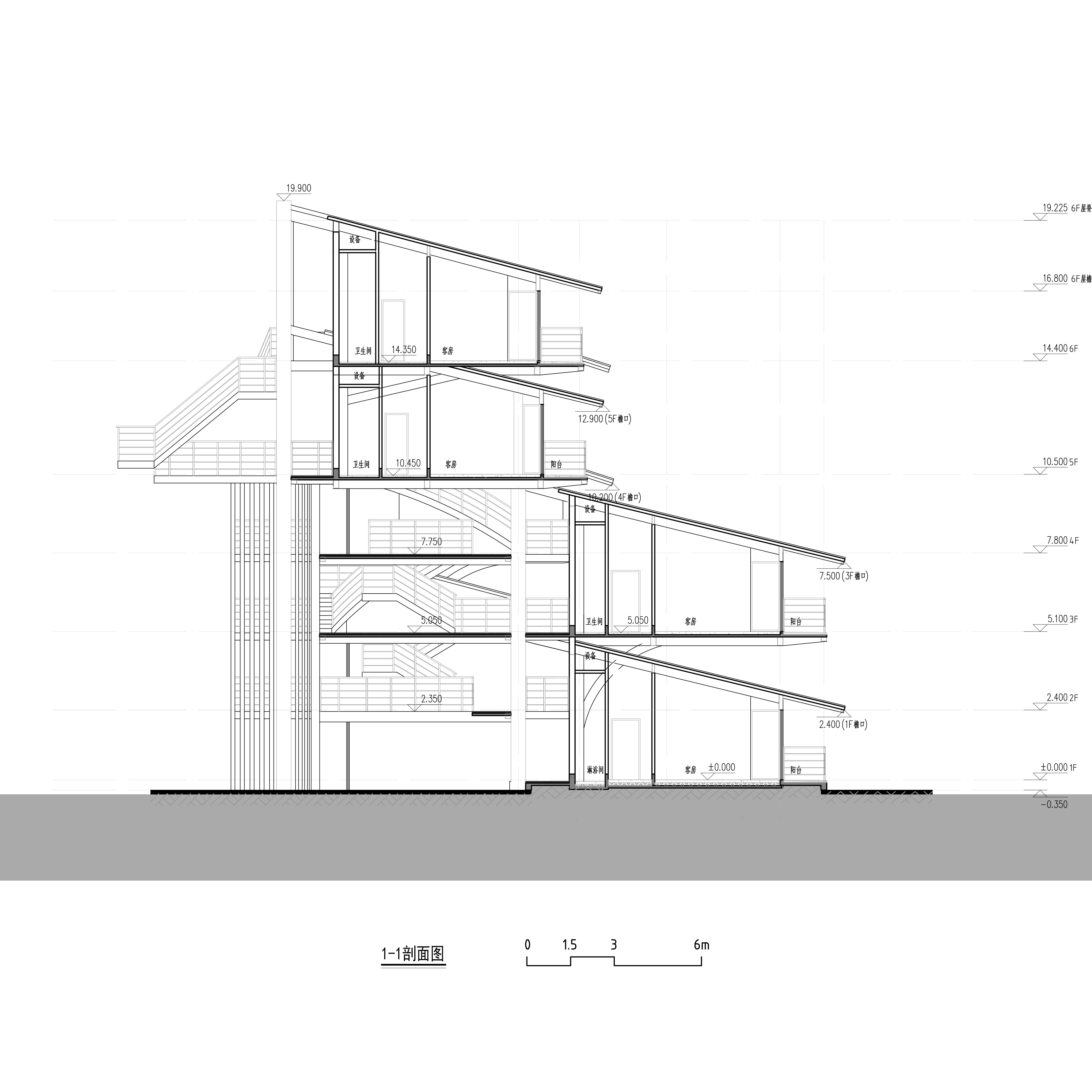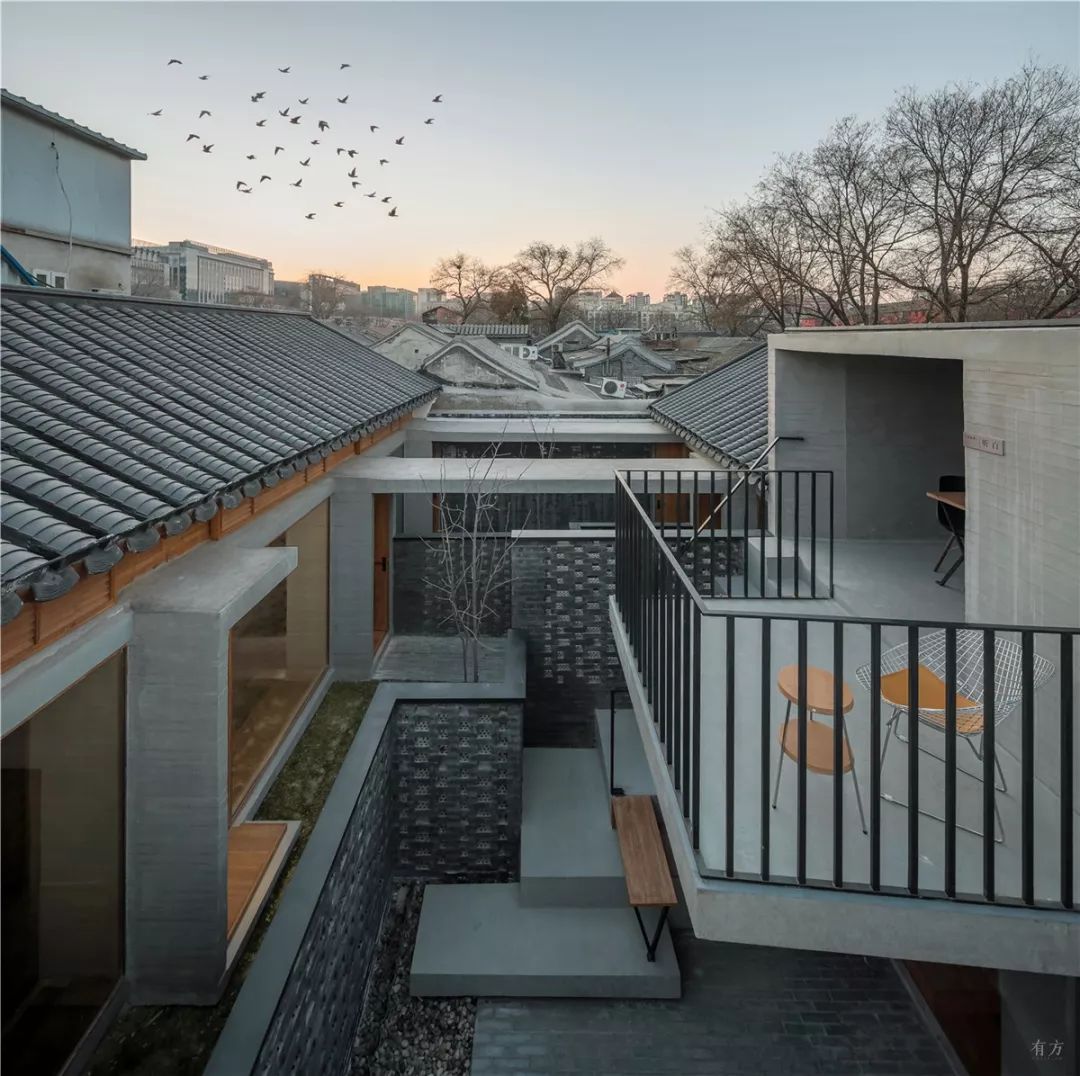
下载app免费领取会员



设计单位 WH studio王晖建筑工作室
项目地点 四川宜宾
建成时间 2024年
建筑面积 1689.12平方米
本文文字由设计单位提供。
树木长到我的窗前,如沉默大地的渴望之声。
——泰戈尔《飞鸟集》
The trees come up to my window like the yearning voice of the dumb earth.
——Stray Birds by Tagore
南溪欢乐田园野趣酒店树屋位于宜宾市南溪区。这个项目是WH studio的树屋产品2.0版,其1.0版是2019年建成的杭州开元森泊度假酒店树屋,位于萧山湘湖。湘湖树屋在文旅市场获得了热烈反响,在短时间内便回收建设成本并持续盈利。它也获得了国内外媒体的关注与报道,成为广告拍摄与网络传播的取景地,被美国著名艺术类网站My Modern Met主动撰文推荐。
Nanxi Happy Pastoral Wild Hotel Tree House is located in Nanxi District of Yibin City. For the designer, this treehouse is the version 2.0 of the treehouse product, and the version 1.0 of which is the treehouse of Hangzhou Xianghu Senbo Resort Hotel, which was built in 2019. Xianghu Treehouse has received an enthusiastic response in the cultural tourism market, and the construction cost has been recovered in a short period of time and continues to make profits. It has also attracted the attention and reports of domestic and international media, and has become a filming location for advertising shoots and network communication. Besides, on the well-known website of My Modern Met, an article was written to warmly recommend the Xianghu Treehouse to the world.
其后,受宜宾南溪业主方的邀请,WH studio接受了树屋新产品的设计任务,进行树屋2.0版的全新探索。1.0版的概念取自原始的“巣居”意象,突出设计与自然元素的融合;2.0版则从“树叶的结构”中获得了启发,更加强调抽象的有机与空中悬浮的状态。
Subsequently, invited by the owner of Yibin Nanxi, WH studio undertook the design task of designing the new product of the treehouse. With the support of the owner, the designer carried out a brand new exploration of Treehouse 2.0. The version 1.0 highlights the integration with natural elements, takeing the original imagery of "nest"; Version 2.0 emphasizes abstract organic and suspended states, especially inspired by the "structure of leaves".

植物的叶片可能是地球上最常见的生物样貌,作为有机体覆盖了最大的地表。从结构角度看,几乎所有的叶片(除了浮游植物)都是悬挑结构。这一结构的矛盾在于,更大的悬挑既带来更多的受光量,又在承受风雨时经受更多的挑战。在漫长进化过程中,植物叶片发展出了多种叶脉,在提供养分的同时支撑着叶片。
Leaf veins can be classified botanically into three main types: forked, reticular, and parallel. Parallel veins are mostly found in slender leaves, such as bamboo leaves; The reticular vein is composed of the main vein and the secondary vein, which is a more common type. The forked vein is a uniform forked branch of the leaf vein after it emerges from the leaf base. Among them, the forked veins are an ancient type, which is rare in seed plants, and the most typical representative is Ginkgo biloba.
叶脉在植物学上可划分为三大类型:平行脉、网状脉和叉状脉。平行脉多见于细长的叶片,如竹叶;网状脉由主脉和次脉构成多级结构,是比较常见的类型;叉状脉从叶基生出后呈均匀的叉状分枝,是古老的叶脉类型,在种子植物中已很少见,最典型代表的是银杏叶。
The leaves of plants are probably the most prevalent biological appearance on Earth, covering the largest surface as organisms. From a structural point of view, almost all leaves (except phytoplankton) are cantilevered, and the contradiction that needs to be resolved is that larger cantilevers bring not only greater exposure to light, but also greater vulnerability to wind and rain. Over the course of a long evolutionary process, which serve to provide structural support for the leaf while delivering nutrients.

在设计者的眼中,银杏树叶有一种“古典的优雅”。作为现存最古老的树种之一,银杏被誉为“植物界的活化石”,其形态已经维持了1亿年以上,经历了沧海桑田和无数生物大灭绝事件而顽强存活下来。银杏的叶片呈扇形,叶脉结构简洁清晰,比例匀称,实现了承接阳光雨露与抵抗狂风骤雨之间的完美平衡。
From the viewpoint of the designer, the ginkgo biloba leaves have a "classical elegance". As one of the oldest surviving tree species, Ginkgo biloba is known as the "living fossil of the plant kingdom", whose form has been maintained for more than 100 million years and has survived countless vicissitudes and mass extinction events. The leaves of ginkgo biloba are fan-shaped, with a simple and clear vein structure and well-proportioned proportions, achieving a perfect balance between receiving sunlight and resisting strong wind and rain.
南溪树屋的基本单元以银杏叶为原型,结构形式类似叉状脉,由根脉出发向外均匀分散,承托起扇形的平面。植物叶片上下之间适当错开,以获得更大受光量,树屋借鉴其做法,在不同高度设置了错落有致的客房单元。客房均朝向主要景观面,但角度各不相同。各单元的结构和空间相互独立,既使整体造型呈现了自然有机的状态,也避免了各单元之间因大悬挑钢结构产生颤动而互相干扰。
The basic unit of Nanxi Tree House is modeled after ginkgo biloba, and its structural form resembles a forked vein, which is evenly dispersed outward from the root vein, supporting a fan-shaped plane. Similar to the proper staggering of the top and bottom of the leaves to allow for maximum light reception, the treehouses are arranged in staggered guest rooms at different heights, broadly facing the main landscape but at different angles. The structure and space of each unit are independent of each other, which not only presents a natural and organic state, but also avoids the interference caused by the slightest fluttering of the large cantilever steel structure.

树屋的主体框架由三根钢柱和主梁构成,形成稳定的三角形,承载了建筑的大部分荷载。叶脉状的一丛结构柱对悬挑底板起到了重要的支撑作用,它们组成的扇形底面、屋顶的扇形斜面以及二者之间的小尺寸钢柱(包括窗框)共同形成了悬浮的结构单元。整个结构体系就像一株植被,树干扎根于大地,而枝叶伸向苍穹。
The tree house as a whole is framed by three steel columns and main beams, forming a stable triangular structure that carries most of the load of the whole building. A cluster of leaf-veined structural columns plays an important role in supporting the cantilevered floor, and its fan-shaped base and the fan-shaped slope of the roof, as well as the small steel columns (including the window frames) in between, form a suspended structural unit. The whole structural system is just like a tree. The trunk rooted in the earth, and the branches and leaves stretching out into the sky.



树叶是坚韧的,也是轻盈的。建筑用纤细的弧形柱与大尺度的悬挑作为支撑,营造出了轻松的漂浮感。建筑虽然没有直接使用具体的树木元素,但仍然带给居住者“栖身枝头、浮游苍穹”的自然氛围。
The foliage is light and tough, with slender curved columns and large-scale cantilevers creating a sense of easy floating. Although the building itself does not directly utilize specific tree elements, it still gives the occupants a natural atmosphere of "perching on the branches and floating in the sky".



三幢树屋各包含六个客房,客房单元的扇形平面与树屋的观景需求十分契合,内部空间构成简洁。卫浴空间位于扇形最内侧,符合空间尺度,满足了私密性要求;入口空间与居住空间被一道独立的直墙分隔,构成了环形流线;外侧的弧形阳台长约12米,提供了无比开阔的观景视野。
Each of the three buildings contains six guest rooms. The fan-shaped floor plan of the guest room units fits perfectly with the view needs of the treehouse, and the interior space composition is simple and clean. The inner section lends itself to a sense of privacy and scale to the bathroom space. A separate straight wall separates the entrance space from the living space, and forms a circular flow, while the curved balcony on the outside, approximately 12 meters in length, provides an unobstructed view.



客房单元各自位于不同的标高,最高处的楼面标高为14.4米。图审部门要求每幢树屋必须设置两部疏散楼梯,给形态和空间处理带来了很大的挑战。在最终定稿的方案中,两部楼梯分别位于主体框架的内部和外侧,提供了一隐一显两种不同的攀登路径。每层的室外平台形态各异,为客房单元提供了室外交流和亲子活动空间。
The guest rooms are at different elevations, with the highest floor level being 14.4 meters. The construction drawing review department required that each treehouse must be equipped with two evacuation stairs, which brought great challenges to the form and spatial treatment. In the final scheme, two staircases are located inside and outside the main frame, providing two different climbing paths, one hidden and one visible. The outdoor decks on each floor are of different shapes, providing outdoor communication and parent-child activity space for the guest room units.

古人云:“我欲乘风归去,又恐琼楼玉宇”。天宫楼阁或许让人觉得高处不胜寒,而在取法自然的树屋中,人们既非聚居也非孑然独处,居住体验可能更为宜人。或凭栏远眺,听鸟鸣啾啾、清风悠悠;或与好友把盏临风,与邻人遥相应和,于熏然神游方外之际,一窥“与天地并生、与万物为一”的逍遥之境。
The ancients said, "I want to go back by the wind, but afraid of the loneliness in the heaven palaces". The heaven palaces may be too high and cold, and the tree house experience which is natural, neither a cluster nor a solitary place may be more pleasant. One can look over by the railing, listen to the chirping of birds and the breeze passing through your ears; Or friends can drink in nature, and the neighbors are in harmony. In a pleasant reverie, they can get a glimpse of the free realm of "living with heaven and earth and being one with all things".




设计图纸 ▽









完整项目信息
项目名称:南溪欢乐田园野趣酒店树屋
主创设计:王晖建筑工作室,王晖
方案设计团队:丁褚桦、刘梦嫚、叶子超、叶云帆
施工图设计团队:胡斌、周莉、王轶楠、曾晨、杨君发、卢芊、代晓寒、欧智
建筑面积:1689.12平方米
设计时间:2022年—2023年
建造时间:2023年—2024年
项目顾问:曾飘、唐庭
项目地址:四川省宜宾市南溪区长江村
业主:宜宾南溪仙源文化旅游发展有限公司
摄影:重庆两江新区三棱镜文化传播有限公司
版权声明:本文由王晖建筑工作室授权发布。欢迎转发,禁止以有方编辑版本转载。
投稿邮箱:media@archiposition.com
本文版权归腿腿教学网及原创作者所有,未经授权,谢绝转载。

上一篇:BIM建筑|张·雷作品:江苏园博园一号入口游客服务中心,自然之石







































